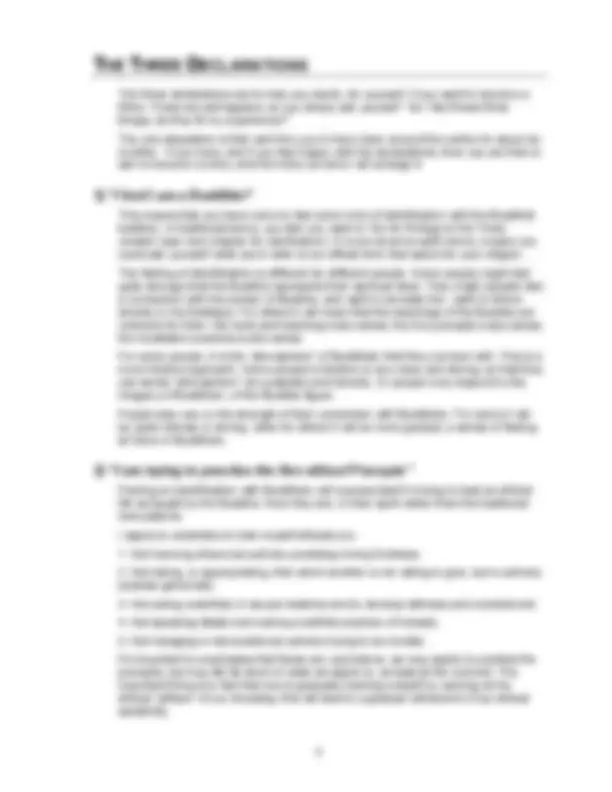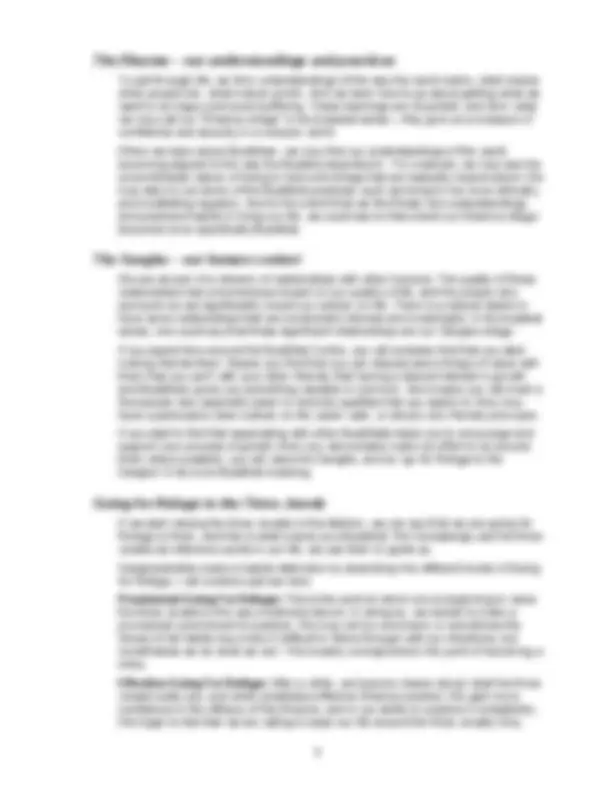








Study with the several resources on Docsity

Earn points by helping other students or get them with a premium plan


Prepare for your exams
Study with the several resources on Docsity

Earn points to download
Earn points by helping other students or get them with a premium plan
Community
Ask the community for help and clear up your study doubts
Discover the best universities in your country according to Docsity users
Free resources
Download our free guides on studying techniques, anxiety management strategies, and thesis advice from Docsity tutors
Information about the Mitra ceremony, a rite of passage for individuals who feel they are Buddhists and wish to deepen their practice within the Triratna Buddhist Community. Becoming a mitra signifies a friendly regard for the community and a commitment to exploring Buddhist teachings and practices. the significance of the three declarations and the role of the mitra convenor in supporting mitras. It also addresses common questions and misconceptions about becoming a mitra.
What you will learn
Typology: Study notes
1 / 12

This page cannot be seen from the preview
Don't miss anything!







A mitra is someone who feels that they are a Buddhist and wants to explore Buddhist practice predominantly within the Triratna Buddhist Community. “Mitra” means “friend” (in Sanskrit, an old Indian language): so a mitra is someone who has a friendly regard for Triratna, and wants to make friends with other people in this community. To find out if you want to be a mitra, ask yourself if you are happy making the following three “declarations” (They are described more in the next section)
Becoming a mitra is intended to be a way for someone to mark a shift from being someone who is interested in Buddhism, or who likes meditating, to being someone who feels a definite affinity with the Buddhist path and wants to join the mitra community. Although this is an internal process, it is very helpful to mark the process externally. Becoming a mitra is a bit like a rite of passage, that can help mark the fact that you have started with a certain degree of determination on a Buddhist spiritual path.
If you are curious or keen to become a mitra, simply ask the “mitra convenor”. If you don’t know who it is, ask any Order member and they will point you in the right direction. The mitra convenor will probably want to meet to talk with you to make sure that you are clear about the meaning of being a mitra, and to talk over the ceremony, and any concerns or questions that you may have. If you have been in contact with the Centre for less than 6 months, you will probably be advised to wait a little. This is so that you have had enough exposure to the Centre and Triratna to be confident that you want to take this step. When you are sure that you do want to be a mitra, the mitra convenor will then arrange a “mitra ceremony” (see “About the Mitra Ceremony”). It may take a few months for the ceremony to come around, as there are only a few ceremonies held each year, so that they remain special occasions. The mitra convenor will liaise with you about possible dates.
The three declarations are to help you clarify, for yourself, if you want to become a Mitra. These are self-applied, so you simply ask yourself “do I feel these three things; do they fit my experience?” The only stipulation is that we’d like you to have been around the centre for about six months. If you have, and if you feel happy with the declarations, then you are free to ask to become a mitra, and the mitra convenor will arrange it.
This means that you have come to feel some kind of identification with the Buddhist tradition. In traditional terms, you feel you want to “Go for Refuge to the Three Jewels” (see next chapter for clarification). In more down-to-earth terms, maybe you could ask yourself what you’d write on an official form that asked for your religion. The feeling of identification is different for different people. Some people might feel quite strongly that the Buddha represents their spiritual ideal. They might actually feel a connection with the person of Buddha, and want to emulate him, want to follow directly in his footsteps. For others it will mean that the teachings of the Buddha are coherent for them: the tools and teaching make sense; the five precepts make sense; the meditation practices make sense. For some people, it is the “atmosphere” of Buddhism that they connect with. This is a more intuitive approach. Some people’s intuition is very clear and strong, so that they can sense “atmosphere” very palpably and directly. Or people may respond to the imagery of Buddhism, of the Buddha figure. People also vary in the strength of their connection with Buddhism. For some it will be quite intense or strong, while for others it will be more gradual, a sense of feeling at home in Buddhism.
Feeling an identification with Buddhism will express itself in trying to lead an ethical life as taught by the Buddha. Here they are, in their spirit rather than the traditional formulations: I aspire to undertake to train myself ethically by:
This declaration is saying that you feel comfortable with the people in Triratna and the approach to Buddhist practice that you have been learning. You feel that it’s the appropriate context for you to progress, at least at present. It is important to have a living context for spiritual development: we have a natural and healthy need for friends and community with a common spiritual understanding. So essentially the community of Mitras is a nexus of friendships. It is for this reason that we refer to the "Mitra Community" or “Mitra Sangha”, which is a community of friends and a context for shared practice.
I’m happy with the Buddhist ideas and practices, but I don’t want to define myself as
a “Buddhist”. Can I still become a mitra?
Read through the section on “Going for Refuge”. If you feel you are going for Refuge to the three Jewels, then no problem — after all, the Buddha didn’t call himself a “Buddhist”. But if Buddhism is more of an interest than an activity for you, then maybe wait a while.
Can I eat meat / drink alcohol / take recreational drugs if I’m a mitra?
There are no fixed requirements in terms of your practice of the precepts, although you would need to feel open to exploring these issues in the light of the precepts. Do not be surprised if you gradually feel more compromised in eating meat or getting intoxicated. Most practitioners gradually (or suddenly!) find that their ethical sensitivity refines so that habits start changing. This is a sign of the practice biting; by cultivating contentment and awareness, for example, you will start to notice discomfort where some habitual behaviours run counter to these qualities.
Do I need to have a regular meditation practice to be a mitra?
Again, there are no requirements, but as meditation is one of the three main aspects of a Buddhist path (along with ethics and wisdom), it would be surprising if you were not at least aspiring to a regular meditation practice.
What if, after becoming a mitra, I change my mind and want to stop being seen as a
mitra?
No problem, just let the mitra convenor know. There’s no special ceremony to “unbecome” a mitra.
Can I still visit other teachers and traditions outside Triratna if I’m a mitra?
There are no rules; the important thing is that when you become a mitra, you are seeing Triratna as your main Buddhist training context, at least for the time being. If you later align yourself primarily with another spiritual movement, you may find that you are uncomfortable in still being a mitra, in which case you can “resign”, although it is not necessary.
in which to make them (usually: flower, candle, incense). The important thing is that whatever you do is an expression of your respect to the three Jewels. People generally bow on approaching the shrine and after making the offerings. It is not necessary to do so, but you may want to try it unless you would feel very uncomfortable or artificial. People quite often kneel before the shrine to bow, and sometimes you will see people making “full prostrations”, ie lying flat on their stomach in devotion. It is not necessary to copy any particular way of showing devotion.
What do I need to bring to the ceremony?
Bring a flower, candle, and stick of incense to offer to the shrine. There is no regulation size, colour or scent. There will be a vase and offering bowl on the shrine to place the offerings in.
What is the significance of the offerings?
When you make an offering to the shrine, it is usually an expression of your respect and receptivity towards the Buddha. It is a way of “underlining” your feeling of commitment to following his example and teaching. The three offerings also have traditional symbolic interpretations: flowers symbolise beauty and impermanence, candles shine forth the light of wisdom, and the scent of incense spreads out like the beneficial actions of an ethical life.
What gives us a sense of confidence and orientation in the confusion of this life? We probably all have built up various ways: we may gain some confidence and security from our career, from our relationships, from being comfortably well-off, or in any number and combination of ways. In the Buddhist tradition, whatever we “place our weight” of confidence on in this way has become known as a “refuge”.
The Buddha saw most refuges as being somewhat insecure when looked at dispassionately, because they are all prone to change: we can be made redundant, our friends may die or move away, our money may get spent. To the Buddhist, the only real sources of security are the three Jewels: the Buddha, Dharma (his teaching and path of practice) and Sangha (the Buddhist community). They are called the three Jewels (“Triratna”) because they are the three most precious things to a Buddhist. This is why the movement is known as the Triratna Buddhist Community – to highlight the fact that we see them as so central. They are also called the three Refuges, because they are seen to be reliable and effectively unchangeable. In the traditional Buddhist texts, when someone met the Buddha and was strongly moved to follow his teaching, they usually are represented as saying something like “To the Buddha for refuge I go, to the Dharma for refuge I go, to the Sangha for refuge I go”. This has become the Going for Refuge formula, which is chanted all over the world by Buddhists, usually in the Pali language (“Buddham saranam gacchami…”), and you will hear it recited within Triratna, for example at pujas. This language of “Going for Refuge to the Three Jewels” is a bit cumbersome, but Sangharakshita — the founder of Triratna — has emphasised that it encapsulates the heart of what it means to be a Buddhist, so it is worth trying to understand what it means. It is easiest to understand the three Jewels in their more general form first, and then see them in their more specifically Buddhist meaning.
The Buddha refuge represents more broadly the potential for growth that we all possess. By having some vision of who we could become, we can orientate ourselves in life: we can live by principles and values rather than being blown around by whims or demands made upon us. And having this sense of purposefulness in life gives it meaning. Maybe we start to suspect that actually there’s no limit placed on how far we can grow – there’s no “glass ceiling”. And maybe we feel that the qualities exemplified by the Buddha represent those that we want to develop – qualities of wisdom, compassion and freedom. And so we realise that there’s nothing in principle stopping us from growing to the stature of the Buddha As this starts happening, the Buddha refuge, in its broader sense of an ideal for ourselves, starts becoming the Buddha refuge in its specifically Buddhist sense.
become our main orientation and purpose in life, and so we commit ourselves to them. This is effective going for Refuge, and is the point at which one can become an Order member.
Becoming a mitra does mark a subtle shift in the relationship between the mitra and the Buddhist centre and sangha.
There aren’t any! Becoming a mitra is a declaration on the part of the mitra, and the Centre provides the context to have that declaration witnessed. It doesn’t endow any particular privileges or duties on behalf of either the mitra or Centre. You don’t need to attend certain events or pay a membership; the Centre isn’t bound to provide any particular events, or a space in a study group. However, in recognition of the new relationship, it is likely that the mitra will have a stronger feeling for wanting to help the Centre; and the mitra convenor will very likely want to help the mitra take their Dharma practice deeper, especially by providing regular study. You will probably find some events or courses that are open only to mitras.
Generally, we aim to provide a four year Dharma Training Course to help mitras deepen their Dharma understanding, and deepen relationships within the Sangha. This takes place within a study group that meets weekly with a study leader. (The Dharma Training Course used to be called the mitra study course)
One of the richest aspect of becoming a mitra is joining the “mitra sangha”. This is potentially a field of friendship, and peer-group support. The mitra sangha is as valuable and enriching as its members make it.
You have probably already experienced the dana relationship, maybe without recognising it as such. “Dana” means generosity, and it signifies the type of relationship that would ideally exist within this community of Buddhists. Dana is the spirit of the second precept: “with open-handed generosity, I purify my body”. It is this spirit that the Centre tries to exemplify as far as possible in its charging structure. All regular classes, study groups, and festivals are offered free of fixed charge. This is not because the Centre doesn’t need any more money! The Centre certainly has constraining financial needs. To the extent that the mitra (or friend, or Order member) wants the work of the Centre to continue and grow, it is hoped that they will want to assist the Centre to do so; this may involve giving money, and/or time, in various different ways. You may particularly want to bear in mind that the mitra convenor is supported financially to
help people like you deepen their practice, and so think in terms of helping to support that person.
When you become a mitra, your name, phone number and address automatically become listed on the so-called “mandala list”. This contains details of all mitras and Order members in the Cambridge sangha, and is made available to everyone on the list. If you would like a copy of the list, or would not like your details listed, then please contact the Centre office.
Do I have to have finished the Dharma Training Course before I become a mitra?
No, it is a course for mitras, not a course to become a mitra.
I don’t have much spare time: what’s the best way to give to the Centre?
Making out a regular standing order to the Centre is an invaluable means of support, even if it’s just to cover the cost of tea and biscuits when you come. Ask a member of the Centre team for a form.
I don’t have any spare money; can I help in some other way?
There are many ways of giving your time to the Centre, for example:
I don’t have time to do the Dharma Training Course – can I still become a mitra?
Yes, there is no need to undertake the course if you don’t have the time or desire to do so.